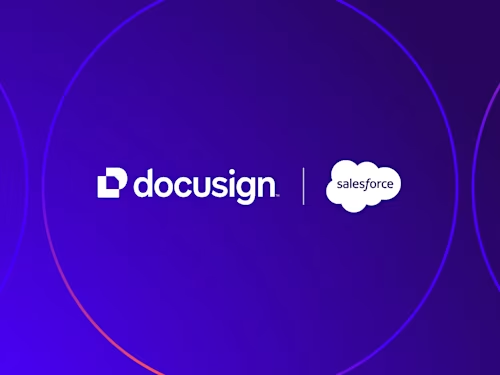
Simplify HR Contracts and Forms with Docusign Templates
Using Docusign templates to create and send common HR forms can save your HR team time and effort while reducing errors.

Throughout the employee lifecycle, many important contracts need to be created, signed, and stored for security and reference by both employees and employers. Using templates to create each of these forms can save tremendous amounts of time and effort on behalf of your HR team and can streamline the employee experience.
From initial interviews to exit paperwork, Docusign for HR can help you create, commit to, and manage employee agreements. Here are some examples of templates that you can create within our product:
The interview process
Before an individual even joins your company, there are still important documents they may need to sign. Here are some examples of contracts you can use Docusign templates for as part of your interview process:
1. Candidate Privacy Notice/Consent
Protecting a candidate's privacy rights is not only good practice but a legal requirement. This document informs candidates about what personal information you'll collect, how it will be used, and who it will be shared with. A template ensures this notice is consistently delivered and acknowledged by every candidate, creating a clear audit trail of consent.
2. Equal Opportunity Agreement
This agreement reiterates your company's commitment to non-discrimination and diversity. By having a dedicated form, you can proactively demonstrate your values and compliance with equal employment opportunity laws. It also serves as a formal record that the candidate has been informed of your policies.
3. Non-Disclosure Agreements (NDAs)
For roles that involve access to proprietary information, an NDA is a critical step. This legal contract ensures that candidates understand the confidential nature of information they may be exposed to during the interview process. Using a template allows you to quickly and securely send, track, and store signed NDAs, providing an immediate layer of legal protection.
Pre-hire
Docusign also offers templates for the most common documents that have to be completed before an employee starts at your organization. Here’s a glimpse:
1. Offer letter
The offer letter is the official contract that lays out the terms of employment, including the start date, salary, benefits, and job title. Having a clear offer letter gives your new hire a look at what they can expect, including any areas they may want to negotiate or ask questions about. An offer letter is the most anticipated contract of the employee lifecycle, so it’s important that it’s accurate and transparent.
2. Form I-9
The I-9 form, also known as the Employment Eligibility Verification form, is a requirement for U.S. employers to verify the identity and work authorization of new employees. This is typically needed before or on a new-hire’s first day, so using a template can come in handy.
3. Background Check Authorization
Before you can run a background check, you must have the candidate's explicit consent. This form grants you the legal right to verify their employment history, education, and other personal information.
New hire onboarding
Once a candidate accepts your offer, the onboarding process begins. This is typically the most administratively dense phase of the employee lifecycle, so your goal is to ensure a smooth transition and efficiently manage all the necessary employment and tax documents without overloading your new employee. After all, they are learning about your company and their new role, so minimizing the amount of paperwork is a must. Templates help keep things moving, especially electronically fillable ones.
1. Form W-4
Form W-4 outlines tax withholdings for your new employee. It is another required document that helps employers determine how much tax to withhold from an employee’s paycheck. Because it is legally standardized, a template is the easiest way to administer it.
2. Benefits selection
This template allows new employees to review their health, dental, vision, and retirement plan options. It can be designed with clear sections and dropdown menus specific to your company’s offerings, making it easy for the employee to select their preferred plans and acknowledge their choices.
3. Employee handbook acknowledgment
Your employee handbook is a comprehensive guide to company policies, values, and procedures. A signed acknowledgment form is essential for confirming that the employee has received, read, and understood the contents of the handbook. This template provides a digital record that can be easily accessed if ever needed.
4. Direct deposit authorization
Simplify your payroll process by collecting banking information with a secure, digital form. This template ensures that all necessary routing and account numbers are captured accurately and confidentially, preventing payroll errors and payment delays–a crucial step in keeping your new hires happy.
General Employment
This phase covers the day-to-day agreements that arise throughout an employee's tenure. Having templates for these forms allows you to quickly and accurately manage changes, performance, and legal obligations.
1. Employee change form
An employee change form is a streamlined way to manage changes to an employee's record, such as name, address, emergency contact information, and title changes and team moves. Templatizing this process means consistency in record-keeping across departments and all employees.
2. Compensation increases and equity grants
Formalize and document changes in an employee's compensation or equity grants. A clear digital agreement ensures both parties are aligned on the new terms.
3. FMLA leave requests
Manage Family and Medical Leave Act requests like pregnancy or disability leave with a standardized form. This ensures all the required information is collected and acknowledged, maintaining compliance and a clear record.
4. Performance improvement plans (PIPs)
When an employee needs to address specific performance issues, a PIP provides a structured framework for improvement. This document outlines clear goals, expectations, and a timeline for completion. Using a template means both the employee and their manager can formally acknowledge the plan, creating a transparent and legally defensible record.
Employee exit
A well-managed offboarding process protects both the employee and the company. Clear, templated agreements for this phase help ensure a smooth and compliant transition, regardless of the reason for departure.
1. Separation agreement or termination letter
A separation agreement is a legal document that may be offered to an employee upon their departure, whether mutual or due to performance issues, layoffs, or restructuring. It often includes terms regarding severance pay, release of claims, and confidentiality. It’s important that the separation agreement is clear and that both parties understand the terms. That’s why a template is a great place to start.
2. Offboarding contract
This contract serves as a checklist for the offboarding process. It may include sections for the return of company property (laptops, phones, keys), final pay acknowledgment, and reminders about post-employment obligations like confidentiality. Using a template ensures that all steps are completed and acknowledged by the departing employee, minimizing risk for your company.
Have an agreement that’s not covered on this list? Docusign allows you to create custom templates so you can standardize even your company’s unique HR processes.
Learn more about how Docusign for HR can help you improve your overall process.
Related posts
Discover what's new with Docusign IAM or start with eSignature for free


